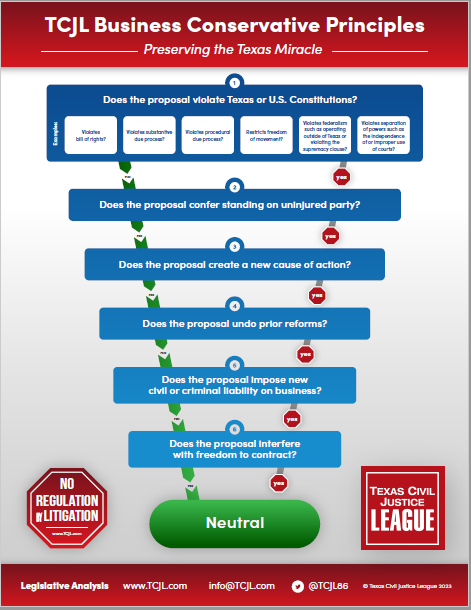
 The Houston-area business court [Eleventh Division] has issued an opinion setting out how to apply a balancing test to the question of (1) whether a protective order should have a separate “Attorney’s Eyes Only” designation, and (2) if so, whether the AEO information should be accessible to a party’s in-house counsel. This appears to be a matter of first impression in state court, though it’s fairly well-developed in federal jurisprudence.
The Houston-area business court [Eleventh Division] has issued an opinion setting out how to apply a balancing test to the question of (1) whether a protective order should have a separate “Attorney’s Eyes Only” designation, and (2) if so, whether the AEO information should be accessible to a party’s in-house counsel. This appears to be a matter of first impression in state court, though it’s fairly well-developed in federal jurisprudence.
Westlake Longview Corp. and Westlake Chemical OPCO LP v. Eastman Chemical Co. (Cause No. 24-BC11B-0023; 2025 Tex. Bus. 19; May 16, 2025) arose out of a contract dispute. Though the parties agreed on the necessity of a protective order in the case, they couldn’t come to terms on whether it should include a separate “Attorney’s Eyes Only” (AEO) designation. They further disagreed on whether any AEO material should be disclosed to in-house counsel. After a hearing, the business court granted the order with an AEO provision with the proviso that the parties “had not shown which information merited an AEO designation or whether specific counsel should have access to AEO-designated materials.”
In an opinion by Judge Andrews, the court explained its reasoning in granting the order with an AEO-provision but limiting access to outside counsel. Under the order, a party designating material as AEO had to redact the AEO-only material so that the rest of it could be disclosed to the other parties. If a party designated the identity of a customer as AEO, the order required the party to specify the scope of the designation, i.e. whether the designation extended to the “mere fact that the entity is or has been a customer the party.”
Because there is “limited authority in Texas regarding when material may be treated as AEO and when in-house counsel may be denied access to it,” Judge Andrews turned to federal case law for guidance. She found that AEO designations are most common in trade secrets cases but have also been used for “other commercially sensitive information,” such as customer lists between competitors. Here Westlake contended that it wasn’t Eastman’s competitor (it bought ethylene from Eastman and didn’t sell it), but Eastman countered that Westlake’s affiliates do sell it, and that those affiliates share Westlake’s legal department. For this reason, Eastman sought to protect the identity of its customers and pricing and other commercial terms in its contracts with third parties. Noting that this is “precisely” the type of information for which federal courts have granted AEO protection, Judge Andrews ruled that Eastman had sufficiently established a case for an AEO provision in the protective order.
At the same time, she observed, “even when dealing with the disclosure of commercially sensitive information to competitors, courts deciding whether any specific information is entitled to AEO protection must balance the risk of harm from disclosure against an opposing party’s need for the information to properly litigate the case” (citations omitted). This balancing test resembles the one employed by Texas courts in applying the trade-secret privilege in Texas Rule of Evidence 507. This involves a “burden-shifting paradigm” in which the “designating party bears the initial burden of proving that the designated information is entitled to AEO protection and must put forward (specific and concrete) evidence that (1) the information is a trade secret or other confidential research, development, or commercial information and (2) there is a risk the party will suffer harm if the information is disclosed to the other party” (citations omitted). If the designating party can do that, the burden shifts to the other side to show why it needs access to the information to litigate the suit and “why providing the information to the party’s outside counsel and experts will not suffice.” This requires a specific reason for the necessity of the information, not just that “the party needs [it] to advise and direct outside counsel,” and that withholding it would cause prejudice.
In this case, neither party presented any evidence on either side of the question. In that event, the court moved on to balancing the parties’ competing interests in determining whether in-house counsel should get the AEO-designated material. In other words, Eastman’s concern that Westlake’s counsel “may inadvertently disclose or use the information for competitive decision-making” must be balanced against “Westlake’s need for its in-house counsel to have access to the information.” First, the court looked to whether Westlake’s in-house counsel was even involved in Westlake’s competitive decision-making, i.e. advising Westlake on or participating in business decisions. This analysis includes any associations the attorney may have with other decision-makers in the company. Culling federal court cases for examples of evidence courts have used to deny or grant attorney access to AEO information, Judge Andrews lays out an extremely helpful list of possible evidence one way or another, but commented that the parties haven’t presented any, and that Westlake made no showing of prejudice if its in-house counsel couldn’t get the information. Consequently, the court denied AEO access to Westlake’s in-house counsel, though it left open the opportunity for the parties to present evidence if one of them moved to modify the protective order in the future.
Judge Andrews’s opinion thoroughly reviews federal case law (the footnote with the citation string takes up half a page) and is clearly designed for other business court judges who have to rule on AEO access, as well as parties who either want it or want to keep the other side from getting it. The opinion really does break new ground in terms of initating Texas case law authority where it doesn’t currently exist. If the business court did not exist, this kind of opinion would have to wait until one or more intermediate courts of appeals was faced with the issue and, quite possibily, on a case to get to SCOTX for the final word on the matter. Think about all the time and money that have been saved by not having to do that. No question that this court will pay for itself many times over in conservation resources, and do it in fairly short order.











